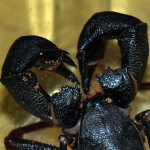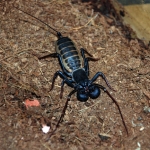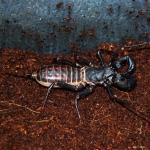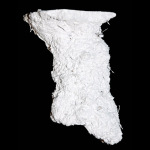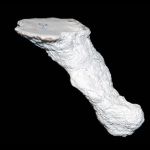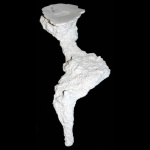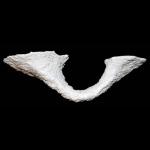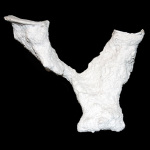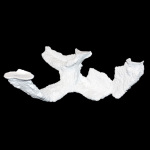Giant Vinegaroon (Mastigoproctus giganteus)
For full details see Hembree (2013) in PALAIOS.
Description of Organism
- One of 110 extant whip scorpion species and one of 14 in the genus
- One of largest whip scorpions; adults can reach lengths of 9 cm
- Characterized by a pair of large claws (pedipalps), a pair of sensory appendages, and six walking legs
- Range includes South America, Cuba, the Antilles, Mexico, and the southern United States
- Inhabits soils in a variety of environments in tropical to subtropical regions
- Nocturnal predators that feed on insects and arachnids
Published Descriptions of Organism
- Whip scorpions (Order Thelyphonida) consist of 110 extant species in 18 genera that are found in tropical to subtropical regions globally from southeastern Asia, Indonesia, Australia, New Zealand, India, Africa, Europe, North America, and South America. The genus Mastigoproctus contains 14 species and occurs in Cuba, the Antilles, Mexico, the southern United States, and South America. While well known and easily recognized, little is known about the ecology and natural history of whip scorpions.
- Whip scorpions are characterized by a pair of large pedipalps (claws), two front legs modified as sensory appendages, and six walking legs. The body is divided into a cephalothorax (prosoma) containing the sensory organs and appendages and a long abdomen (opisthosoma). Whip scorpions have three to six pairs of eyes on the top and sides of the prosoma, but have limited vision, and instead rely upon their two sensory appendages that can be used for tactile sensation, as well as sensory hairs that can detect vibrations. Whip scorpions possess a long, flexible tail (flagellum) at the end of their abdomen. Opening at the base of the tail are a pair of glands that produce an acetic acid secretion that can be sprayed 20–40 cm as a defense mechanism.
- Whip scorpions inhabit a wide variety of environments across their geographic range. While the majority of species occur in tropical rainforests, a few including M. giganteus, are found in such arid deserts as the Sonoran and Chihuahuan deserts of Mexico and the southwestern United States. Whip scorpions are nocturnal predators and commonly feed on a variety of arthropods including orthopterans, hemipterans, beetles, and spiders. Mastigoproctus in particular, as well as other whip scorpion genera, seek shelter in rock crevices, under surface vegetation, and in abandoned burrows of other animals, in addition to constructing nonpermanent burrows of their own. While their ability to burrow is well known, the morphology of whip scorpion burrows has not been described.
- Mastigoproctus giganteus is one of the largest of the whip scorpion species, reaching body lengths of 40–60 mm as adults. Mastigoproctus giganteus is a common part of the terrestrial arthropod fauna of arid to semiarid regions of the southwestern United States and Mexico as well as scrub environments of Florida. Individuals of this species have a life span of 4–7 years and reach sexual maturity in 3–4 years. Mastigoproctus giganteus, like other whip scorpions, is a nocturnal predator that feeds on a variety of arthropod prey. Individuals demonstrate an aversion to bright light and seek shelter in daylight. Studies of water loss in M. giganteus have shown that their evaporative water loss (EWL) is exponentially related to body weight. This water loss increases significantly above 26 uC in adults even when exposed to high levels of humidity (90%–95%). These observations have led to the conclusion that the epicuticle of this species is not an effective barrier to EWL and is a likely reason for both the nocturnal and fossorial nature of the species particularly given the environment that it occupies.
Burrowing Technique
Mastigoproctus giganteus uses its pedipalps to excavate and transport sediment from the burrow. The pedipalps are racked against the sediment surface and burrow walls to collect masses of loosened material. The packages of loose sediment are grasped by the pedipalps and carried out of the burrow. Vinegaroons are able to transport sediment in this way equally well across flat ground or while backing out of a vertical burrow. The sediment is deposited 10 to 20 cm away from the burrow entrance. The vinegaroon is capable of producing a burrow large enough for its entire body in approximately 1 hour, however, the burrow is continuously modified over the time of occupation.
Burrowing Technique Videos
Burrowing Behavior
Mastigoproctus giganteus uses burrows as temporary shelters to permanent dwellings. Typically, one to two burrows are created initially and then subsequently abandoned having never been inhabited or having been occupied for less than 24 hours. The sediment excavated from the burrow can be used to cover a shallow burrow or to infill specific tunnels within more complex burrows. New shafts and tunnels are continuously constructed, adding to the complexity of the burrow system over time. A standard burrow may progress from a vertical shaft or subvertical ramp to a J-shaped burrow, a U-shaped burrow, a Y-shaped burrow, and finally a mazework. Not all burrows progress to the mazework stage before being abandoned, however, and sometimes the vinegaroon will infill parts of the burrow to make it less complex over time. This often results in the isolation of the vinegaroon in a single open chamber with no connection to the surface.
Trace Morphology
Mastigoproctus giganteus produces six distinct burrow architectures: vertical shafts, subvertical ramps, J-, U-, and Y-shaped burrows, and mazeworks; examples of each are shown below. Each photo is linked to an information page about the specific burrow architecture.
